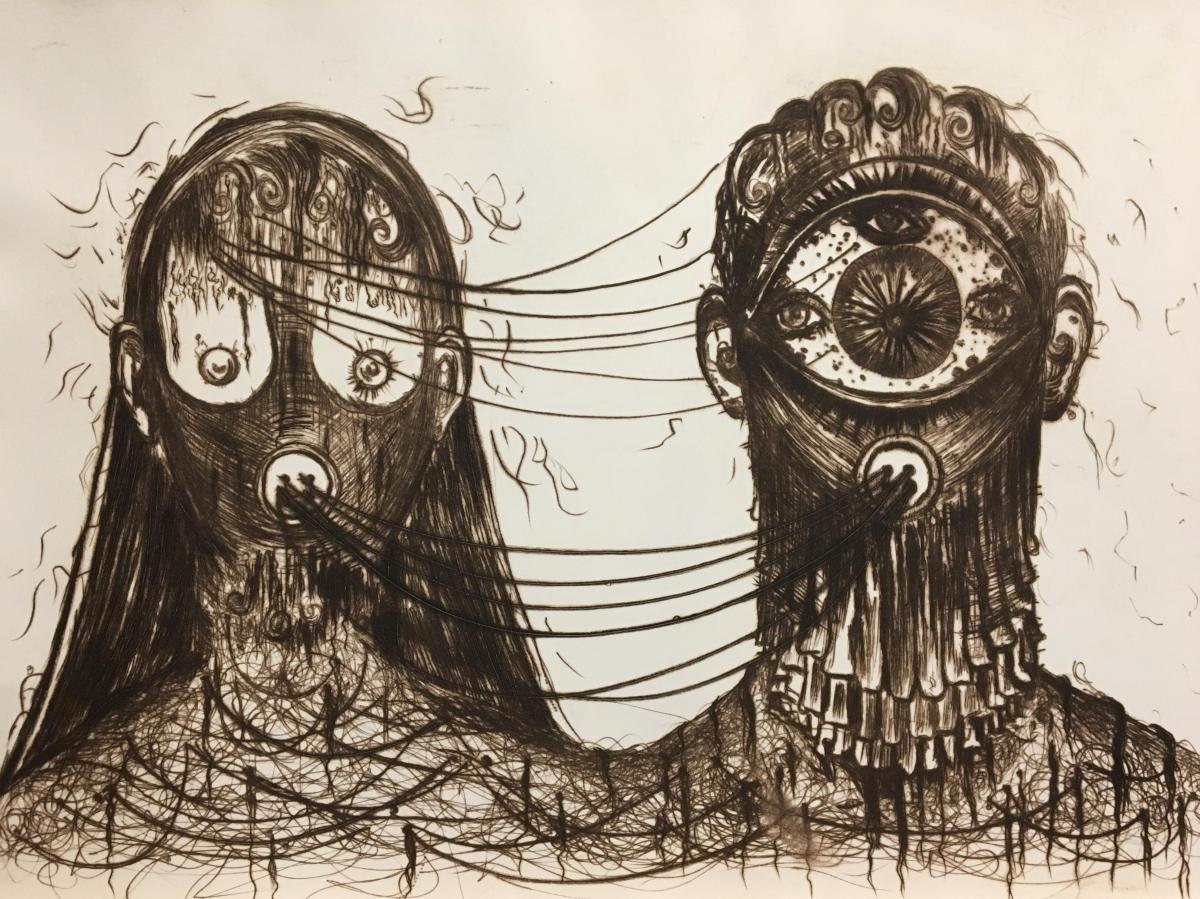Amir Tehrani, Thread 1; courtesy the artist
The Walker Street Gallery & Arts Centre in Greater Dandenong has a special reason for celebrating arts from diverse backgrounds.
According to curator David O’Halloran, ‘It used to be Western Sydney, but after the recent census, Dandenong was named the most culturally diverse city in Australia. More than four in five have a parent born overseas, and more than 70% speak languages other than English. They come from 157 different birthplaces. This is why we are passionate about this project.’
Now in its fourth year, HOME is an annual exhibition that celebrates artists from a refugee or asylum seeker background. Six artists have been selected from a national callout and will present their work from 18 October until 30 November.
The artists are: Amir Tehrami, Tadros Hanna, Mirwais Janbaz, Lobsan Dhoyou, Zia Atahi and Elyas Alvi.
Afghani Mirwais Janbaz told ArtsHub: ‘I have been living in Australia a very short time, and in this short time I was chose (sic) for this exhibition, which I feel very privilege.’

Image courtesy the artist Mirwais Janbaz
Janbaz arrived in Australia in April this year, after almost 20 years fleeing a life of violence as a Dari-speaking minority. He has been making art since he was a child, and since moving to Australia he has taught art classes to other refugees.
‘Art doesn’t know politics or borders; It is the one thing in the world that can connect one part of the land to another part of the land, from one country to another,’ said Janbaz.
Like many Australian artists, he has set up a studio and gallery in his garage. Home gives him that sanctuary to make his art. He added that the theme was also particularly apt for him as he was born – literally – in his home.
‘I was born in civil war in Afghanistan in the house, and at that time, mum explained, there was fighting going on so too difficult to go to the hospital. I grew up in civil war … but I continue with the art; I never give up.’
The series he presents for HOME explores themes of dark and light where women are struggling in another part of the world, and yet he doesn’t consider his work to be political or decorative, but rather that it comes from a spiritual or humanitarian place.
O’Halloran has a guiding principle which reflects the artists’ own experience of their journey. ‘We are treating the participants as artists first,’ he said. ‘That is the key; their refugee status comes second’.
He said they selected just six artists to show in depth with a suite of works, rather then being just one piece in a roll call of 20 plus artists.
‘It is about treating them as artists, not just a topic,’ said O’Halloran. ‘I have tried to make the show a balance between the artists telling their stories and letting them run with their own artistic interest.’
Iranian artist Amir Tehrani (pictured top) has an interest in how people need to be constantly connected both physically and mentally in a fragmented world, while Afghani photographer Zia Atahi’s lyrical images present a body that reaches out of a heavy mist, speaking to notions of security, risk and a reach for home.
O’Halloran added: ‘There are a number of exhibitions that are put together in the refugee and asylum seeker space. We are trying to do something else – these people are artists, they are in a new culture, and perhaps they need some assistance to get their professional careers in place.’
That too is a key idea. Rooted in distant tragedy, the artists want to be supported as part of Australia’s broader cultural life. They need to be accepted as professionals, to be known and make a living.
O’Halloran said of the mentoring that has come out of this year’s edition of HOME.
‘There is an artist based in Adelaide, Elyas Alavi who is already established but his need is a continual conceptual dialogue about his work. We connected him with Rubaba Haider who is also working in this [conceptual] space, so they can have a professional conversation about their ideas,’ explained O’Halloran.
Alavi will present two video works in HOME, one that talks about the affect of a bombing on people and leans towards a documentary style, while the other is a documented performance in the artist’s former city of Pakistan that demarcates where Afghanis are allowed to live in the city – a conceptual line.’

Tadros Hanna, My Vision; courtesy the artist
O’Halloran continued: ‘Tadros Hanna trained in Egypt as an architect but is now doing abstract painting. Through the HOME mentorship he was paired with Gary Willis, who is passionate about painting, and will nurture Tadros in how he can get his name known a bit more in art industry spaces.’
All of the artists presented in HOME received $1000 from sponsor IKEA Springvale to support the development of new work.
This is an exhibition to linger in our minds. As Janbaz said, ‘I wanted to send this message that we don’t know which time we will leave this world. All of us belong to this land – land does not belong to us; there should not be border. We make these lines so we do not allow the other people to move. As a refugee for 20 years in Pakistan I had no legal identity – I had no home.’
‘People in Australia have lots of facilities, but they don’t know the worth of the facilities they have here. That is what I want to show,’ Janbaz told ArtsHub.
HOME is showing from 18 October – 24 November at the Walker Street Gallery & Arts Centre, corner of Walker and Robinson streets, Dandenong (VIC)




